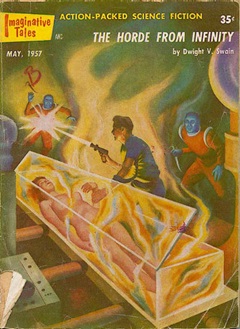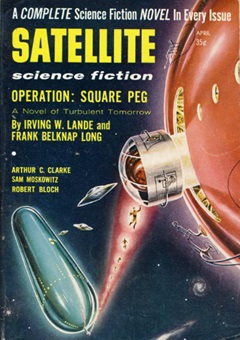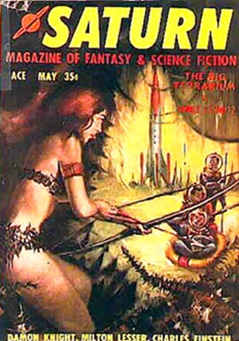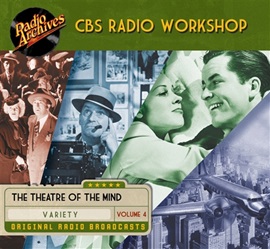CBS Radio Workshop (1956-57) aired “Light Ship” on April 28, 1957 as the 65th of its 86 episodes. Though short-lived and arriving on the stage near the very end of the Golden Age of Radio’s day in the sun, the CBS Radio Workshop was praised for its experimentation and innovation–its willingness to take chances with format, style, and subject matter. This is perhaps best described by the introductory line for each episode:
“Dedicated to Man’s imagination–-the theater of the mind.”
Actually, this program contained 84 complete episodes and not 86, for it decided to expand two stories into two half hour episodes, the first being Aldous Huxley’s Brave New World (narrated by Orson Welles), Parts 1 & 2 on January 27th & February 3rd, 1956 respectively, with the second two-parter being Frederik Pohl & Cyril Kornbluth’s The Space Merchants, Parts 1 &2 on February 17th & February 24th, 1957 respectively. Though the show would adapt other SF/F genre stories (several of which we have showcased over the years), it did not limit itself to any one genre, attracting an audience who appreciated not knowing what to expect from week to week, and who reveled in the program’s freshness and ability to challenge its listeners.
While searching for this week’s episode I came across the title “Light Ship” and thought it might connote something of a science fictional nature, so gave it a listen. While the ship of the title had nothing to do directly with science fiction, its story was so captivating I decided to share it here anyway, and along the way happened to discover a connection to what might be considered a present day and ongoing science fictional parallel after all.
Light ships were small, self-contained vessels manned by a tiny crew for the purpose of warning ships at sea nearing shore to beware of hidden reefs and other dangers, especially useful in times of storm-tossed seas where visibility aboard the larger ships was reduced to almost nothing and normal landmarks were rendered invisible. The Light ships functioned much as a shore bound lighthouse, but further out to sea, where they would moor at select locations and set alight two oil drums at fore and aft of their vessel, their illumination warning big ships of impending danger and to avoid the twin flames from the much smaller guardian vessels. Those aboard the Light ships would sign on for six month stints before their relief came, and it took a special breed of sailor to perform at the level required not only to handle the physical day to day duties, but to possess the psychological stability essential to one living in a closed environment for long periods of time with only a few others for companionship, and be trained to handle any unplanned or life-threatening situations the sea and unpredictable weather might bring their way. Thus, the stage is now set for a tense, harrowing adventure when such a life-threatening occurrence takes place, and the physical and psychological strength of the men of the Light ships is tested when they are locked down for an extended period of time, with little hope for rescue in sight, with food and other supplies running out at an alarming rate.
It is this scenario that offers its connection to the current science-fictional scenario concerning two astronauts stranded in space with no plan for an immediate rescue in sight. Two NASA astronauts aboard Boeing’s Starliner spacecraft launched on June 5th from Cape Canaveral’s Space Force Station in Florida. Their initial mission was to dock with the International Space Station (ISS) and return to Earth for what was to be an 8-day mission. But—and to make a long story short—problems occurred prohibiting their immediate return. Though they have access to the larger ISS and its 7 astronauts, and are in no danger of running out of food, water, or air, their relief is now projected to be sometime in early 2025. Much like the Light ship crew in this week’s old time radio production, their physical and psychological stamina will nevertheless be severely tested, regardless of their location: one being in a storm-tossed ocean and the other in the limitless ocean of space. Also of (perhaps minor) coincidence is that “Light Ship” aired exactly 5 months and a week before the dawn of the Space Age on Earth, for on October 4, 1957 the Soviet Union launched the Sputnik satellite into orbit around the planet. So listen now to “Light Ship” and get a glimpse of how nature takes the measure of men in a time of adversity and know they will be tested time and again, even into the future and the unknown depths of space where, if these examples are any indication, humanity will be ready to answer the call.
(The linked CD above contains this episode and 19 others, all digitally remastered.)
Play Time: 24:04
{“Light Ship” aired on a Sunday evening in late April of 1957. The neighborhood gang couldn’t wait for school to end the next day so they could make their way to the nearby newsstand to discover magazines whose stories they hoped would excite them the way “Light Ship” had done the night before. They were in luck. Imaginative Tales (1954-58) was created by publisher William Hamling as a sister magazine to Imagination, which he had just purchased from Raymond A. Palmer. It quickly morphed from running humorous fantasy novels to more or less a twin of Imagination with its usual space opera fare. The rise of the paperback and the demise of one of the country’s largest distributors, American News Company in 1957, would spell doom for both magazines (and many other magazines relying on ANC as their distributor), and both died in 1958. Imaginative Tales was bi-monthly in 1957. Satellite Science Fiction (1956-59) proudly proclaimed it ran “A COMPLETE Science Fiction NOVEL in Every Issue,” and sweetened the pot with heavyweight names on its covers to attract readers; names like Isaac Asimov, Arthur C. Clarke, Lester del Rey, Robert Bloch, and Jack Vance among others. Two of the original novels were by none other than Algis Budrys and Philip K. Dick, though the level of these two were hard to match in the long run. Even so, chances are that the magazine’s timing was its worst enemy, for like other magazines of the time it had to compete with the growing paperback market along with the coup de grace of one of the nation’s largest book and magazine distributors (American News Company, begun in 1864) closing shop. Satellite SF was a bi-monthly in 1957. Saturn Magazine of Fantasy & Science Fiction (1957-65) was an odd duck of sorts, beginning its existence as an SF magazine that lasted only 5 issues (the one pictured below was its 2nd). After Saturn‘s 5th issue it became Saturn Web Detective Magazine for 4 issues, then Web Detective for another 10 issues, finally settling on Web Terror Stories until the end of its highly irregular run in 1965. It managed 4 issues in 1957, 3 as a bi-monthly and the 4th as a quarterly.}
[Left: Imaginative Tales, 5/57 – Center: Satellite SF, 4/57 – Right: Saturn F&SF, 5/57]



To view the entire list of weekly Old Time Radio episodes at Tangent Online, click here.

